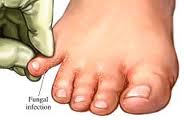Did you know that skin problems can actually be used as a sign of health problems? The emergence of a mole, change in skin color and various other skin problems can be a clue to the health problems that will occur.
Here is a list of signs that indicate the presence of health problems, more than just a common skin problems:
* The face of pale: pale skin can be associated with anemia which showed a lack of sufficient iron to make hemoglobin fatherly, where the hemoglobin is responsible for transporting oxygen from the lungs throughout the body.
* Yellowing of skin color: Changes in skin color becomes yellowish orange can be one sign of hypothyroidism - or less active thyroid gland - which led to increased levels of beta-carotene (a type of antioxidants found in fruits and vegetables) in the blood. Issues affecting the thyroid gland means the body is unable to absorb antioxidants quickly, which causes the accumulated beta-carotene. Yellowing of the skin which, if followed by discoloration of the eyes who co-yellowing, can be a sign of liver disease.
* Dark lines in the palm of the hand: black lines on the palms or the deepening of pigment in the palm creases may indicate adrenal insufficiency, an endocrine disorder, also known as Addison's disease. Primarily, this disease affects women and men aged between 30 to 50 years.
* Scars brown on the dry bones: If at the front of the leg along the shin looks brown spots or the emergence of small blood vessels that eventually began to bleed, then that is a sign of diabetes.
* The color purple on the skin: If you see any purple color on one surface of the skin, it means a few broken blood vessels and can occur due to circulation problems or a lack of vitamin C. Purple spots are often mistaken for bruises are likely to arise in a long time compared with that produced purple spots due to bruising.
* Red spots resembling a butterfly on the face: A red rash shaped butterfly that usually arise in bone (bridge) the nose and cheeks, often the first sign of autoimmune disease Lupus, which is a life-threatening disorder and requires treatment right. Or it could be contact dermatitis or rosacea.
Acne: Although acne is a common problem in adolescents and some women, acne can be changed to polycystic ovary disease or PCOS. Acne is the result of hormonal imbalance and can be addressed with lifestyle changes and certain drugs.
* Sagging skin: The skin is loose may be a sign of dehydration. By filling out the appropriate body fluids, naturally, dapaat prevent skin menngendur. For optimal health, doctors recommend drinking eight glasses of water fatherly per day.
* Swelling in your lower eyelids: a swollen skin under the eyes indicates that you are eating too much salt, these activities (to consume lots of salt) can increase the risk of hypertension and high blood pressure.
* Flesh-colored skin peeling on the back: with colors such as flesh wounds that occur in the lower back is a sign of a rare genetic disease called tuberous sclerosis that causes benign tumors to grow in the brain and other vital organs.
* Andeng-andeng (moles): Although most andeng-andeng not dangerous, be careful, because they (andeng-andeng) can develop melanoma, a type of skin cancer the most deadly. If andeng-andeng are flat or colored to pink, then andeng-andeng tend to become cancerous.
Although the above conditions is an indication that there is a disease that will arise, but there are many skin conditions that do not indicate a problem with the body. It is best for you of course is to consult with experts (doctors) if it finds something unusual.

No comments:
Post a Comment